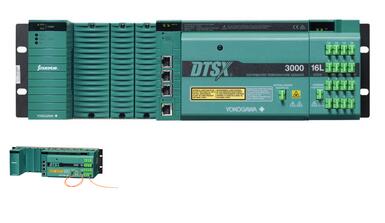Distributed Temperature Sensing DTSX3000
DTSX3000 is a long range integrated optical fiber sensing system built on a process control platform. Primarily used for temperature sensing, the compact hardware platform offers a wide range of temperature measurements up to 50km! Because of its low power consumption capability, DTSX3000 can be installed in remote areas running on solar power. Yokogawa's DTSX3000 is built on Yokogawa's PLC & SCADA platform, therefore, it is the only distributed temperature sensing system that also offers control capability.
Yokogawa sets a new standard for distributed temperature sensing in performance, distance, price, and intelligence that reduce operating cost and increase production. The DTSX3000 modular design allows interchangeable configurations up to 16 fiber optic channels, control I/O module and various power supply options.
DTSX3000 is a long range integrated optical fiber sensing system built on a process control platform. Primarily used for temperature sensing, the compact hardware platform offers a wide range of temperature measurements up to 50km! Because of its low power consumption capability, DTSX3000 can be installed in remote areas running on solar power. Yokogawa's DTSX3000 is built on Yokogawa's PLC & SCADA platform, therefore, it is the only distributed temperature sensing system that also offers control capability.
Yokogawa sets a new standard for distributed temperature sensing in performance, distance, price, and intelligence that reduce operating cost and increase production. The DTSX3000 modular design allows interchangeable configurations up to 16 fiber optic channels, control I/O module and various power supply options.
What Is Distributed Temperature Sensing?
Distributed temperature sensing (DTS) measures temperature distribution over the length of an optical fiber cable using the fiber itself as the sensing element. Unlike traditional electrical temperature measurement (thermocouples & RTD), the length of the fiber optic cable is the temperature sensor. Distributed temperature sensing can provide thousands of accurate and precise temperature measurements over a long distance. Compared to traditional electrical temperature measurements, distributed temperature sensing represent a cost effective method for obtaining accurate and high resolution temperature measurement.
How Does It Work?

Yokogawa DTSX3000 measures temperature and distance over the length of an optical fiber using the Raman scatter principle. A pulse of light (laser pulse) launched into an optical fiber is scattered by fiber glass molecules as it propagates down the fiber and exchanges energy with lattice vibrations. As the light pulse scatters down the fiber optic cable, it produces stokes signal (longer wavelength) and anti-stokes (shorter wavelength) signal, of which both signals shifted from the launch of the light source. The intensity ratio of the two signals components depends on the temperature at the position where the Raman scatter is produced. This temperature can thus be determined by measuring the respective intensities of the stokes and anti-stokes signals. Furthermore, part of the scattered light, known as the backscatter, is guided back towards the light source. The position of the temperature reading can thus be determined by measuring the time taken for the backscatter to return to the source.
What Is Raman Scatter Principle?

All light interacts with matter! For example, imagine standing in a pitch black garage with no external light source. Inside this garage is a bright red sports car. Needless to say, you cannot see the sports car or the color of the sports car itself. However, when you turn on the lights to the garage, you can immediately see the light source reflecting the bright red color off the car. The light that is bouncing off the red sports car is only bouncing off the "red" spectrum, therefore, your eyes see the sports car as, well, red.
This phenomena is also true when you shoot a pulse of light (laser pulse) off of a molecule, in this case, the fiber glass molecule in the optical fiber cable. When the light source enters the optical fiber cable, most of the light bounces (backscatter) back unchanged (no change in wavelength). However, a small amount of that light shifted/changed. That shift/change from the light source is called Raman Scatter. Since Raman Scatter is thermally influenced by temperature, the intensity depends on temperature. Distributed temperature sensing is capturing the shift/change from the propagating light pulse and measuring the intensities between the two signal components (stokes and anti-stokes).
What Are The Advantages of Using DTS?
Cost! When an application requires hundreds or thousands of sensors to be measured, it becomes very expensive to wire each individual sensor back to a data acquisition station. It is much more cost effective and beneficial to acquire accurate and high resolution temperature measurement using fiber optic cable.
Long distance! It is difficult to measure temperature over a long distance using traditional electrical measurement sensors. Not only can DTS fiber optic cable be deployed over a long distance but it also provides a high resolution profile of the area as well as accurate and precise temperature measurement over that distance.
High electromagnetic noise environment! DTS is isolated from electromagnetic noise because of its optical characteristics. Unlike traditional electrical measurement sensors (thermocouple & RTD) there is no electrical component within the optical fiber, therefore, it is immune to electromagnetic noise.
No knowledge of sensor placement! It is not always possible to identify the correct location to deploy temperature sensors ahead of time. Because of the high spatial resolution along with long distance capability of DTS, engineers can deploy multiple optical fiber along the same area to ensure precise and accurate temperature.



